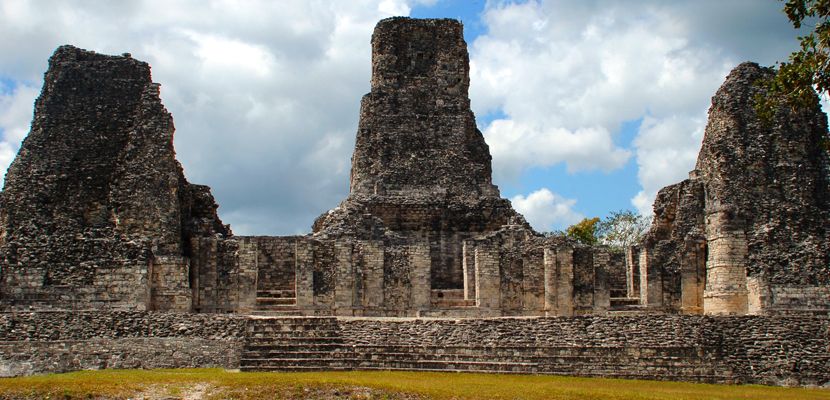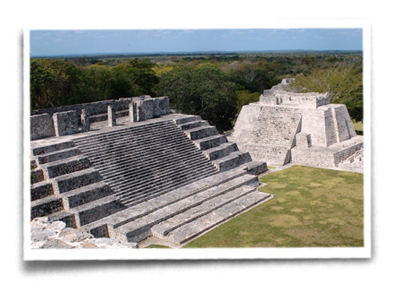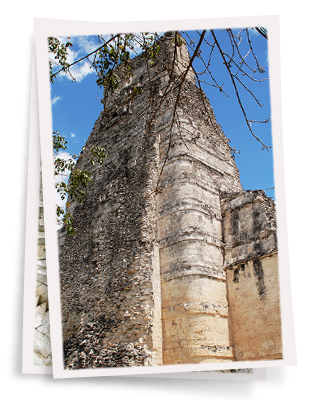


Day 1: Arrive at airport, Ciudad del Carmen 12:00, where you will be greeted and transferred to our first stop: lunch on the beach at Sabancuy on the Gulf of Mexico. After lunch we transfer to our Ecolodge at Chicanna, where will settle in for two days. Our first visit is to see one of the largest surviving and best preserved Maya stucco friezes at Balamku. On this frieze we can see highly stylized earth monsters, monkeys and most importantly, toads, as they represent man’s connection to the spirits and the earth. (L)
Day 2: Travel to the Calakmul Biosphere Reserve and Calakmul Ruins. Known as the Snake Kingdom, Calakmul was a great center of power dating from the late pre-Classic to the early Classic period. In fact, Calakmul was the greatest power in the region, known as Peten, and with a network of alliances, lead successful campaigns against its rival empires, Tikal and Palenque. Calakmul was finally defeated by Pakal of Palenque in 695 A.D, which lead to its ultimate demise. Today, the Calakmul Biosphere Reserve, the largest area of protected land in Mexico, is home to many species of flora and fauna, which on recent visit included spider and howler monkeys, tapir, white tailed deer, toucans, ocellated turkeys, orioles, parrots, hawks and more. Unfortunately (or fortunately) none of the wild cat species appeared, such as jaguar, puma or tigrillo. After our extended visit to this rich cultural and environmental region, we enjoy lunch on homemade fresh tortillas, beans and more, at an area campsite. We return to relax at our lodge and pool, followed by a leisurely evening and visit to Veinte de Noviembre to meet present day Maya artisans. (B,L,D)
Day 3: Visit the heart of the Rio Bec region of Campeche which was settled in the pre Classic period of 550 BC, yet flourished in AD 650-900, following the demise of Calakmul. Becan was the dominant center of this region, with Chicanna and Xpuhil being satellite towns. Becan remained inhabited as late as 1300 AD, which means that this site covers a vast period of Maya civilization. Here, we will review the unique Rio Bec style of architecture, characterized by a series of three towers, false staircases and columns. We leave the Rio Bec region and head north to Campeche City and the Chenes region. Arriving in Campeche City, we settle into our hotel and enjoy dinner. (B, L)
Day 4: Attend a two hour seminar hosted by the University of Campeche: first hour is dedicated to reviewing the periods, regions, styles and alliances of the Maya Civilization, and second hour is dedicated to learning of present day Maya communities, language and traditions, to better understand the threats facing indigenous populations in Mexico. After our classroom session we fast forward to the 1600’s where we imagine ourselves as pirates and board a sailing vessel for a water front tour of Campeche (no ransacking!) Our lunch continues on the water front, followed by a historical city walking tour that will focus on the sea and land walls that were erected to stave off the pirates. At night, we attend a magical light and sound show that depicts this history in a more theatrical fashion. Tonight, we dine at the local favorite, Portales San Fransisco to taste local panuchos and pan de casuela. (B,L)
Day 5: Guided tour of the archeological site of Edzna that combines Chenes and Puuc styles and was located at the crossroads of major trade routes between the Chenes and Puuc regions in the north, and Peten, Rio Bec and Usumacinta in the south. Returning from the site, we receive a guided visit to the Fuerte San Miguel, a former fort which now houses a fabulous museum of Mayan art. Sadly, we leave Campeche for Yucatan, but make one last stop in Becal to see how local artisans weave jipijapa palm fiber into hats, purses and decorative items. From here we push north to Uxmal, the Classic Mayan city of the Puuc period. Tonight you have the option to see the awe inspiring Light and Sound show, an unforgettable homage to the rain god, Chac. (B,L)
Day 6:Today begins at the Classic Puuc site of Uxmal, followed by other sites on the Puuc route, such as Sayil, Kabah and Labna, where we see great examples of the Puuc style palaces and arches, originally discovered by Stephens and Catherwood in the 1840’s. From here, we leave the world of ancient history behind, traveling to the sunny, white sandy beaches, blue waters of Celestun. Oftentimes, however, the water appears pink, as thousands of greater flamingoes converge here to feed on their favorite variety of shrimp. This is in fact the reason why flamingoes are pink…it is in their diet. Speaking of diet, we too will eat shrimp and other seafood at our favorite beachfront palapa. From here, we travel to Merida where we settle in for four days in this vibrant, tropical, colonial capital city. (B)
Day 7: Leisurely city tour of Merida, which includes the Museum of Anthropology. In the evening, we stroll to the Santa Lucia plaza, where each Thursday the State Band plays to an eager crowd of locals. (B)
Day 8:Early departure to the post Classic city of Chichen Itza, lunch is in colonial Valladolid, followed by afternoon visit to Ek Balam. Evening in Merida offers an optional Salsa Lesson #1. (B)
Day 9:Travel to the colonial city of Izamal in the day. Evening in Merida offers optional Salsa Lesson #2 and farewell dinner. (B,D)
Day 10:Depart